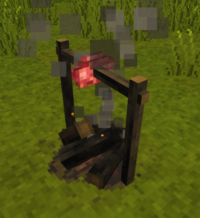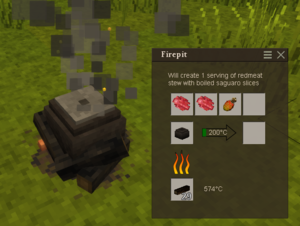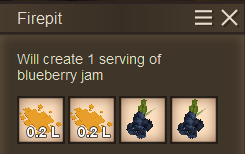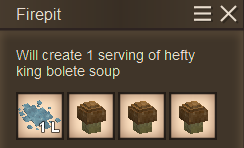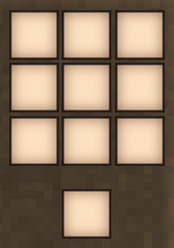Cooking/fr: Difference between revisions
(Created page with "===Cuisiner des repas=== ''Voir aussi: Meals''") |
(Created page with "Préparer un repas est une méthode avancée de cuisson qui augmente la valeur alimentaire de tous les ingrédients utilisés et offre des avantages et une commodité supplémentaires. Les plats cuisinés peuvent être conservés au frais très longtemps dans des pots scellées ; manger des repas stoppera complètement la perte de satiété pendant un certain temps ; et le joueur ne gaspillera jamais la nourriture d'un repas lorsqu'il lui procure plus de satiété que ce...") Tags: Mobile edit Mobile web edit |
||
| Line 125: | Line 125: | ||
[[File:Jam.png|300px|thumb|right|Each ingredient should be placed in separate slots, and equal amounts of all ingredients must be added.]] | [[File:Jam.png|300px|thumb|right|Each ingredient should be placed in separate slots, and equal amounts of all ingredients must be added.]] | ||
Préparer un repas est une méthode avancée de cuisson qui augmente la valeur alimentaire de tous les ingrédients utilisés et offre des avantages et une commodité supplémentaires. Les plats cuisinés peuvent être conservés au frais très longtemps dans des pots scellées ; manger des repas stoppera complètement la perte de satiété pendant un certain temps ; et le joueur ne gaspillera jamais la nourriture d'un repas lorsqu'il lui procure plus de satiété que ce dont il a besoin. | |||
To begin, craft at least one [[bowl]] and one [[cooking pot]] using the [[clay forming]] mechanic, and fire them like all ceramics in a [[pit kiln]]. Placing the fired cooking pot into the firepit input slot (upper left) will open up an additional four-slot inventory above the input slot, in which ingredients can be combined into one of the five available meal types. The meal type players create is determined by which two "required" ingredients are placed into the cooking pot first. | To begin, craft at least one [[bowl]] and one [[cooking pot]] using the [[clay forming]] mechanic, and fire them like all ceramics in a [[pit kiln]]. Placing the fired cooking pot into the firepit input slot (upper left) will open up an additional four-slot inventory above the input slot, in which ingredients can be combined into one of the five available meal types. The meal type players create is determined by which two "required" ingredients are placed into the cooking pot first. | ||
Revision as of 19:17, 3 December 2023
Aliments comestibles Cru
Au début du jeu, sans infrastructure, le joueur n'as accès qu'au ressources lié au ramassage et à la chasse qui peuvent être mangé afin de maintenir la Saciété du joueur. Cependant, le joueur ne doit pas s'en servir trop longtemps, car une fois récoltés, les aliments naturels disparaissent pour de bon ou nécessitent beaucoup de temps pour repousser.
Le tableau suivant liste tout les ingrédients qui peuvent être mangé cru:
| Item | Satiété | Catégorie | Notes |
|---|---|---|---|
| Miel1 (per 0.1 liter) | 30 | Fruits | Liquide. Ne pourris jamais. |
| Cerise, litchis | 40 | Fruits | |
| Canneberge | 60 | Fruits | |
| Saguaro fruit | 60 | Fruits | Restaure 1 pv quand consommé. |
| Pomme (tout type), myrtille, groseille (tout type), mangue, orange, pêche, poire, grenade ou tranches d'ananas |
80 | Fruits | |
| Fruit à pain | 120 | Fruits | |
| Champignon (tout type) | 80 | Légumes | Certain types de champignons peuvent être toxiques et donner des dégats lors de leur consommation. |
| Poivron2, carotte, olive, oignon, panais ou navet | 100 | Légumes | |
| Manioc (traité) | 100 | Légumes | Non comestible sans traitement préalable. |
| Chou | 300 | Légumes | |
| Tranche de citrouille | 140 | Légumes | |
| Citrouille mûre (Entière) | 480 | Légumes | |
| Grain de lin | 30 | Céréales | |
| Grain d'amarante, riz, seigle, épeautre ou de tournesol | 60 | Céréales | |
| Grain de noyer | 40 | Protéines | Ne pourris jamais. |
| Grubs or Termites | 60 | Protéines | |
| Arachides | 160 | Protéines | |
| Morceau de graisse3 | 200 | Protéines | Ne pourris jamais. |
| Boeuf séché | 280 | Protéines | Rare loot des ruins. Restaure 2 pv quand consommé. Ne pourris jamais. |
| Lait (par 0.1 litre) | 15 | Laitages | Liquide. |
1 Consommer du miel étais utilisé pour restaurer des PV dans les ancienne versions. Ce n'est plus le cas à partir de la version 1.16.
2 Les poivrons ne sont pas obtenable en survie normal à partir de la version 1.16.
3 Les morceaux de graisse sont un matériel de fabrication précieux qui ne devrais être consommé qu'en cas d'urgences.
Champignons
Les Champignons sont particulier dans le sens où ils peuvent être bénéfique ou nocifs au joueur quand consommé et certain des nocifs sont vraiment facilement confondus avec ceux sûrs.
Ci-dessous une liste spécifiquement sur les champignons toxique pour une vérification simple:
| Name | Notes |
|---|---|
| Bolet amer | -3 HP |
| Amanite phalloïde | -50 HP (!) |
| Hydnelle de Peck | -2 HP |
| Scléroderme | -8 HP |
| Helvelle lacuneuse | -7 HP |
| Amanite tue-mouches | -6.5 HP |
| Galère marginée | -40 HP (!) |
| Lactaire à lait doré | -2.5 HP |
| Pleurote de l’olivier | -6 HP |
| Mycène rose | -10 HP |
Cuisine Basique
La première opportunité de préparer de meilleurs nourritures vient avec le foyer. Un petit nombre d'aliment de la chasse ou du ramassage peuvent être placé directement dedans pour y être transformés. De plus il peut être utilisé pour cuire les pâtes en pain en in clin d'oeil, mais le résultat sera de moins bonne qualité que d'utilisé un four en argile.
Ci dessous la liste de tout les ingrédients qui peuvent être traité dans le foyer:
| Item | Satiété | Catégorie | Notes |
|---|---|---|---|
| Racine de roseau cuite ou racine de papyrus cuite | 100 | Légumes | |
| Pain de lin (carbonisé) | 100 | Céréales | Nécessite un traitement préalable. |
| Pain d'amarante, de manioc, de seigle, d'épeautre ou de tournesol (carbonisé) | 210 | Céréales | Nécessite un traitement préalable. |
| Pain de riz (carbonisé) | 220 | Céréales | Nécessite un traitement préalable. |
| Viande de gibier cuite | 120 | Protéines | |
| Volaille cuite | 200 | Protéines | |
| Viande rouge cuite | 280 | Protéines | |
| Poisson cuit | 200 | Protéines |
Cuisine Avancé
Les techniques de cuisson avancées peuvent augmenter considérablement la valeur alimentaire des ingrédients et peuvent potentiellement atteindre plusieurs milliers de points de satiété dans un seul aliment. En plus de cela, cela permet au joueur de préparer des repas à partir de plusieurs ingrédients, ce qui peut potentiellement approvisionner plusieurs groupes nutritionnels en même temps. Dans la mesure du possible, il est recommandé au joueur d'utiliser les techniques de cuisson avancées.
Cuisiner des repas
Voir aussi: Meals
Préparer un repas est une méthode avancée de cuisson qui augmente la valeur alimentaire de tous les ingrédients utilisés et offre des avantages et une commodité supplémentaires. Les plats cuisinés peuvent être conservés au frais très longtemps dans des pots scellées ; manger des repas stoppera complètement la perte de satiété pendant un certain temps ; et le joueur ne gaspillera jamais la nourriture d'un repas lorsqu'il lui procure plus de satiété que ce dont il a besoin.
To begin, craft at least one bowl and one cooking pot using the clay forming mechanic, and fire them like all ceramics in a pit kiln. Placing the fired cooking pot into the firepit input slot (upper left) will open up an additional four-slot inventory above the input slot, in which ingredients can be combined into one of the five available meal types. The meal type players create is determined by which two "required" ingredients are placed into the cooking pot first.
- To cook a single serving of a meal: place one of each required item into two separate cooking pot slots (this defines the meal type). For example, a porridge requires "two grain", so a player must add two individual pieces of grain in any two input slots in the cooking pot. Placing two grain in one input slot of the cooking pot will not create a porridge. Adding "optional" ingredients in the other two input slots of the cooking pot will increase the nutrition value and satiation of the meal depending on which items are added. When a valid meal recipe (combining correct ingredients) is placed into the input slots, a message will appear in the cooking pot dialog box informing players about what type of meal will be created after cooking.
- To cook multiple servings of a meal: increase the number of ingredient items added to all slots equally. The cooking pot allows players to cook up to 6 servings of any meal at a time. When creating multiple servings all the items in the input slots must be increased by the same amount, or the food will not cook!
- To cook meals requiring liquids: liquids like water or honey can be added in 1L increments with a bucket, or 0.1L increments with a bowl - however the 0.1L increments are for now only required for jam made from honey. While holding the container with the mouse, LMK to add one portion, RMK to remove it again.
- To fill a bowl: A bowl holds one meal portion and may be filled from a cooking pot or food storage crock. To fill a bowl, place the container of cooked food onto a solid surface. With the empty bowl in the active hand use RMB on the cooking pot or crock. Bowls and crocks may be filled with meals while the cooking pot is in the firepit. Bowls of food may be carried in player inventories, stored in stationary containers, and placed on shelves. Bowls cannot be filled from crocks on shelves.
- To eat a meal: Food may be consumed from a filled bowl. With the filled bowl in an active hotbar slot, eat using RMB. Players will eat until full, which may leave partial portions of food in the bowl.
- To store meals: Four portions of any cooked meal can be stored in an empty crock. Place the pot onto the ground or table and right click the pot with an empty crock to transfer meals to the storage crock. Storage crocks may be sealed for long term storage using fat or wax in the crafting grid. Crocks may also be carried in player inventories, stored in stationary containers, and placed on shelves.
Meal Recipes
| Advanced Recipes | Meat Stew | Vegetable Stew | Porridge | Soup | Jam | Scrambled Eggs |
|---|---|---|---|---|---|---|
| Required Ingredients | 2 poultry or red meat (cured or fresh) | 2 vegetables or soybeans | 2 grain | 1 vegetable (fresh) + 1L water1 | 2 fruit + 2x 0.2L honey1 | 2 egg |
| Optional Protein | 0 - 2 protein | 0 - 2 soybeans | 0 - 1 poultry or red meat (cured or fresh), or egg | |||
| Optional Vegetable | 0 - 2 vegetable | 0 - 2 vegetable | 0 - 2 vegetable | 0 - 2 vegetable | 0 - 2 vegetable | |
| Optional Grain | 0 - 2 grain | |||||
| Optional Fruit | 0 - 1 fruit, 0L - 0.2L honey1 | 0 - 2 fruit, 0L - 0.2L honey1 | ||||
| Optional Dairy | 0 - 2 cheese |
1 Liquids can be added to the pot with a bucket (1L portions), jug (0.3L portions), or bowl (0.1L portions). Pick up the liquid container with your cursor and drag it over an empty spot in the cooking pot. Use LMB to add one portion, RMB to remove one portion.
Meal Food Values
The satiety received from eating meals is equal to the sum of its ingredients. The ingredients added to create the meal determine how much satiety of each class of nutrition the player receives. In addition, the food values of most ingredients are increased via cooking, as shown in the table below.
Pickled variants of listed ingredients can be used, but provide only their tooltip-listed food value, without gaining any bonus from meals.
Ingredients not listed in this table cannot be used in cooking pot meals.
Note: for every 100 satiation filled by consuming a meal, an additional 30 seconds passes before the player's satiety bar starts dropping again for any reason. Consuming a large meal can result in more than five minutes of completely free healing, sprinting, heavy armor wearing, or other strenuous tasks.
| Protein | Satiety in Meal | Vegetable | Satiety in Meal | Grain | Satiety in Meal | Fruit | Satiety in Meal | Dairy | Satiety in Meal |
|---|---|---|---|---|---|---|---|---|---|
| Soybean | 240 | Field vegetables1 or olives | 150 | Flax grain | 120 | Blueberries or currants (any) | 120 | Blue cheese (slice) | 200 |
| Egg | 200 | Cassava | 120 | Rice grain | 280 | Tree fruits2 or pineapple slice | 120 | Cheddar (slice) | 240 |
| Poultry, cured or fresh | 375 | Pumpkin slice | 180 | Rye or spelt grain | 240 | Cranberries or saguaro fruit3 | 90 | ||
| Redmeat, cured or fresh | 420 | Cabbage | 450 | Amaranth or cassava grain | 240 | Honey (0.2L) | 80 | ||
| Mushrooms3 (any) | 120 | Sunflower grain | 240 |
1 Field vegetables include carrots, parsnips, onions, turnips, and bell peppers.
2 Tree fruits include apples, breadfruit, cherries, lychees, mangoes, oranges, peaches, pears, and pomegranates.
3 Ingredients that restore player health when eaten raw, such as saguaro fruit, lose this benefit when cooked. However, cooking a poisonous mushroom does not remove its harmful effects - the meal will still damage the player!
Baking
Baking is an advanced cooking method that revolves around dough, the creation of which requires some setup. A quern must be available, which requires metal tools to craft. Additionally, a clay oven should be set up for baking, as not all recipes can be baked in the firepit, and the results there are always subpar. Plus, a Wooden Bucket, a Jug or a Bowl is needed to be filled with water. Finally, a farm is required to consistently supply useful amounts of grain, as wild crops are nonrenewable, mature extremely slowly, and reset their growth after reaching maturity.
In return, baking is one of the best ways to process grains that exists in the game, with up to a five-fold yield multiplier compared to eating the raw grain.
To create dough, prepare flour by using a quern to grind grain, then mix the flour with water.
Open the quern GUI and add grain into the input slot on the left of the quern.
- Hold
interact on the top of the quern to grind the grain into flour, which will appear in the output slot on the right of the quern.
During later stages of the game, a windmill may be used to drive the quern.
- In the crafting grid, combine a bucket of water and flour to create dough. Each flour item will consume one unit of water from the bucket.
Two foods can be baked at the moment: bread and pie. Both of them represent a significant advantage over consuming grain as porridge, and fully-filled pies can grant enormous nutrition with long spoilage times. Each serving of pie also halts the hunger meter for 30 seconds, greatly helping players with high hunger rates due to equipping heavy armor or offhand items.
Food Storage
Check the Food preservation page to learn how to best store all those delicious meals!
Video Tutorials
| Claypot Cooking (no real changes since version 1.12) |
|---|
| Wiki Navigation | |
|---|---|
| Vintage Story | Guides • Foire aux questions (FAQ) • Vintage Story Original Soundtrack • Versions • Controls |
| Systèmes de jeu | Artisanat • Taille de pierre • Modelage d'argile • Forge • Cuisine • Température • Faim • Minage • Stabilité temporelle • Puissance mécanique • Commerce • Agriculture • Élevage |
| Le Monde | Création du monde • Biomes • Météo • Tempêtes temporelles |
| Objets | Outils • Armes • Armure • Vêtements • Sacs • Matériau • Nourriture |
| Blocs | Terrain • Plantes • Décoratifs • Éclairage • Fonctionnels • Minerai |
| Créatures | Entités hostiles • Animaux • PNJs • Joueurs |
| Miscellaneous | Liste des commandes client • Liste des commandes serveur • Mode Créatif : Guide de prise en main • Bot System • How_to_use_WorldEdit • Caméra cinématique • Enregistrement de vidéos à taux variable • ServerBlockTicking |

